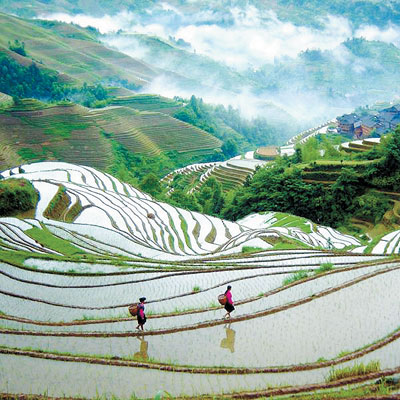Longji Rice Terraces,Natural Gem of Chinese Ethnic Groups
LATE spring is one of the best times of the year to visit the Longji Rice Terraces in Longsheng, Guangxi Zhuang Autonomous Region.
In the mountainous area, around 12 hours’ drive from Shenzhen, lies the most amazing terraces in China demonstrating the profound wisdom and strenuous labor of the Zhuang people.
Situated in northeast Guangxi, Longsheng was the earliest county established in southern China. Longsheng City is in a densely forrested area, 100km north of Guilin in the area of the Heping and Sang rivers.
Longsheng itself is a rather common and noisy Chinese town lacking character, but it’s a must stopover and transit hub for a trip to the famous Longji Rice Terraces in Ping’an and Jinkeng.
The amazing rice-terrace scenery is two hours from Longsheng City, with minority villages scattered throughout the area including the Zhuang villages of Ping’an and the Zhuang and Yao villages of Zhonglu, Dazhai and Xiaozhai.
The 60 sqkm rice terraces southeast of Longsheng were first built in the Yuan Dynasty (1279-1368) and completed in the Qing Dynasty (1644-1911) by Zhuang people, on land sloping down to the riverside from the highest elevation of 885m down to 380m.
It is no exaggeration to say that where there is soil, there is a terrace. The terraces are found in the valley beside swiftly flowing rivers to the mountain tops with swirling clouds, or bordering verdant forest and cliff walls.
Even though the Longji Rice Terraces are large, they are made up of numerous patches no more than one mu (about 0.16 hectares). The outline is very smooth with gradients between 26 degrees and 35 degrees.
The rice terraces form beautiful natural scenery that varies from season to season. In spring, the fields are irrigated and the terraces look like great chains or ribbons hung on the hillsides. With the onset of summer, waves of green seem to flow down the mountainside. The theme for autumn is the harvest, when the mountainside takes on the golden color of ripened millet. Coming into winter, the mountains are covered with snow, just like dragons playing with water.
Apart from its amazing scenery, Longji is also in an area where some of China’s ethnic minority culture can be experienced. The Zhuang and Yao nationalities inhabit the area although it is mainly inhabited by the Zhuang people. The women dress in unique, colorful costumes and enjoy singing and dancing. Guests can join them to experience the original Zhuang way of life and culture. They are also able to stay with local families and enjoy Longji tea and Longji wine.

Best times to go
Of the four seasons, spring is the best time, when the green rice terraces are filled with water while autumn offers an array of striking colors.
How long to stay
A minimum of two days is recommended, and you can spend a few more days at the mountaintop just relaxing and counting the terraces.



